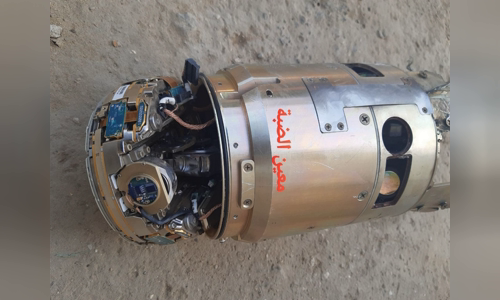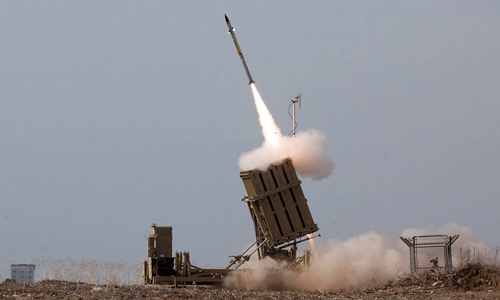The Iron Dome system is specialized in dealing with jet and mortar artillery, developed to protect Israel from short-range enemy attacks.
The Israeli Air Force on November 12 launched an air strike to destroy Baha Abu al-Ata, the senior commander of the Islamic militia movement in the Gaza Strip. Gunmen in the Gaza Strip responded by launching a total of 200 rockets into southern and central Israel, but about 190 were intercepted by the Iron Dome.

The cluster of Tamir missiles and detonators landed in the Gaza Strip on November 12 Photo: Twitter/Jtruzmah.
Iron Dome is a short-and-medium-range air defense complex developed by Israel's Rafael and the US Raytheon Corporation. The system has been fired numerous times since it was commissioned in 2011 and has proven effective in successfully intercepting a wide range of rocket and mortar artillery shells launched by Gaza Strip armed groups in Israel.
The development of Iron Dome began after the war in Lebanon in 2006, when the Hezbollah armed group continuously poured "rocket rain" into Israeli territory. Nearly 4,000 bullets, mainly BM-21 series rocket launchers, landed in Haifa and areas north of Israel, killing 44 inhabitants and evacuating 250,000 people in less than a month of conflict.
Also during 2000-2008, more than 8,000 mortar and rocket shells were launched from the Gaza Strip into southern Israel. Gaza armed groups are equipped with 122-meter-wide jet guns with ranges over 20 km, threatening nearly one million residents in southern Israel.
In response to this threat, Israel's Ministry of Defense aims to develop a short-range mobile air defense system to deal with uncontrolled artillery shells in February 2007. This complex successfully fired for the first time in March 2009, but has not practiced intercepting the target.
Tests continued until mid-2010, when Iron Dome was strong enough to classify targets and only intercepted objects that could endanger its protected area, while ignoring the fruit. The bullets fell uninhabited. Israel is operating 10 Iron Dome systems and may add 5 more units in the future.
A complete Iron Dome complex costs about $ 50 million, including three main components: the radar and target tracking, combat management and fire control (BMC) and 3-4 launch platforms. (MFU). Each MFU platform is equipped with 20 Tamir interceptors with a range of 70 km.
The Tamir missile, which costs $ 40,000 per unit, uses a highly sensitive active radar detector and data link to increase detection and intercepting small targets such as rockets and mortar shells. This cluster of devices directs the bullet very close to the target, before the near-target laser detonator activates the explosive tip to destroy the threat.
The interception process began when the radar detects the rocket and mortar fired by the enemy. It will monitor and calculate the flight path and expected drop point of the target. If the shell is in danger of falling into the protected area, the system will alert the crew to operate or automatically fire the Tamir missile.

The Iron Dome system ignited Hamas rocket in 2012 Photo: IDF
Iron Dome usually launches two bullets at each target to increase their ability to intercept. The rocket detonated in an empty area, avoiding debris falling into residential areas.
"Iron Dome is not just a missile defense system. It is a symbol of the imagination applied to reality, allowing the use of rockets to destroy an aerial rocket," military expert Michael Peck said. .
However, Iron Dome is not an impenetrable system. Israeli defense officials have acknowledged that it still has a lot of acupuncture points that can be exploited by the enemy, as well as a high rate of false alarms and false launches.
This shield only killed about 240 of the 690 rockets launched by the Hamas armed group in the Gaza Strip from the morning of 4/5 to 6/5. It was the largest jet attack by the force against Tel Aviv, killing four Israeli civilians.
General Yaakov Amidror, former head of the Israeli Military Intelligence Research Department, admitted that Hamas rocket launch into Israeli territory during this attack was not particularly special, but a series of weaknesses such as "insufficient reaction time". and the flawed prediction algorithm made Iron Dome powerless.
"The high density of the fire and the high firepower of these warheads caused great damage to the lives and assets of the enemy," said Abu Obeida, spokesman of Hamas Izz ad-Din al-Qassam Brigade. , wrote on social media after the attack.
Iron Dome also repeatedly alarmed, causing financial losses when launching a series of bullets at unrealistic targets. A complex of Iron Arches launched 10 Tamir missiles consecutively on the night of March 25, 2018, after a rocket alert was coming. However, the results of the investigation showed that it was only the sound of machine guns fired by Hamas forces towards Israeli territory.
That makes this shield met the criticism of many Israeli military experts. "Iron Dome has become a sleeping pill for the people and the military leadership of Israel. Since its inception, the people and leaders of Israel have only become accustomed to intercepting rockets," Lt. Col. Yoni Chetboun, security adviser Security at Netanya Council, said May 7.



 GurwinderKaur
GurwinderKaur







